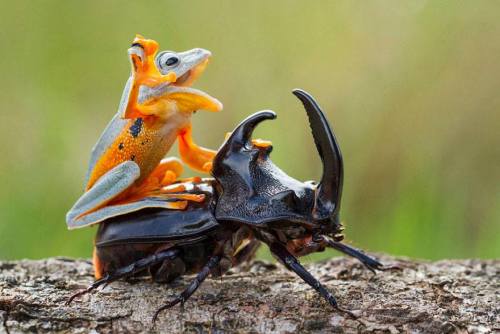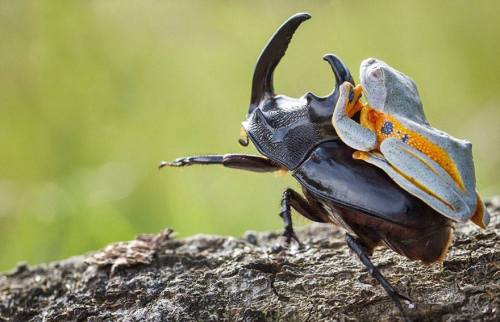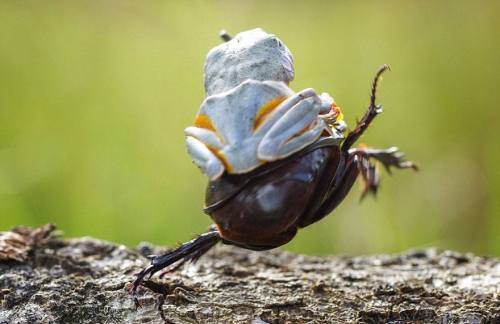😍😍😍😍😍😍
😍😍😍😍😍😍




Levi knocking Kenny out, s03e02
More Posts from Ourvioletdeath and Others

What are memories made of? Study sheds light on key protein
Ask a nonscientist what memories are made of and you’ll likely conjure images of childhood birthday parties or wedding days. Charles Hoeffer thinks about proteins.
For five years, the assistant professor of integrative physiology at CU Boulder has been working to better understand a protein called AKT, which is ubiquitous in brain tissue and instrumental in enabling the brain to adapt to new experiences and lay down new memories.
Until now, scientists have known very little about what it does in the brain.
But in a new paper funded by the National Institutes of Health, Hoeffer and his co-authors spell it out for the first time, showing that AKT comes in three distinct varieties residing in different kinds of brain cells and affecting brain health in very distinct ways.
The discovery could lead to new, more targeted treatments for everything from glioblastoma—the brain cancer Sen. John McCain has—to Alzheimer’s disease and schizophrenia.
“AKT is a central protein that has been implicated in a bevy of neurological diseases yet we know amazingly little about it,” Hoeffer said. “Our paper is the first to comprehensively examine what its different forms are doing in the brain and where.”
Discovered in the 1970s and known best as an “oncogene” (one that, when mutated, can promote cancer), AKT has more recently been identified as a key player in promoting “synaptic plasticity,” the brain’s ability to strengthen cellular connections in response to experience.
“Let’s say you see a great white shark and you are scared and your brain wants to form a memory of what’s going on. You have to make new proteins to encode that memory,” he said. AKT is one of the first proteins to come online, a central switch that turns on the memory factory.
But not all AKTs are created equal.
For the study, Hoeffer’s team silenced the three different isoforms, or varieties, of AKT in mice and observed their brain activity.
They made a number of key discoveries:
AKT2 is found exclusively in astroglia, the supportive, star-shaped cells in the brain and spinal cord that are often impacted in brain cancer and brain injury.
“That is a really important finding,” said co-author Josien Levenga, who worked on the project as a postdoctoral researcher at CU Boulder. “If you could develop a drug that targeted only AKT2 without impacting other forms, it might be more effective in treating certain issues with fewer side-effects.”
The researchers also found that AKT1 is ubiquitous in neurons and appears to be the most important form in promoting the strengthening of synapses in response to experience, aka memory formation. (This finding is in line with previous research showing that mutations in AKT1 boost risk of schizophrenia and other brain disorders associated with a flaw in the way a patient perceives or remembers experiences.)
AKT3 appears to play a key role in brain growth, with mice whose AKT3 gene is silenced showing smaller brain size.
“Before this, there was an assumption that they all did basically the same thing in the same cells in the same way. Now we know better,” Hoeffer said.
He notes that pan-AKT inhibitors have already been developed for cancer treatment, but he envisions a day when drugs could be developed to target more specific versions of the protein (AKT1 enhancers for Alzheimer’s and schizophrenia, AKT2 inhibitors for cancer), leaving the others forms untouched, preventing side-effects.
More animal research is underway to determine what happens to behavior when different forms of the protein go awry.
“Isoform specific treatments hold great promise for the design of targeted therapies to treat neurological diseases with much greater efficacy and accuracy than those utilizing a one-size-fits-all approach,” the authors conclude. “This study is an important step in that direction.”




Onward, steed!
Your grandmother bequeaths a statue of an angel to you in her will. You find it creepy, but not having the heart to sell it, you store it in the basement. The next morning, to your horror, the basement door is wide open, and there is a note lying where you left the statue. Picking it up, you barely make out the scrawled words. “Find me before I find you.”
After the missile struck their moon at an appreciable percentage of the speed of light, scientists manage to translate the message that followed its arrival; “That was a warning. We did not miss. The next one will be wrapped in Cobalt. Do not threaten us.”





(x)
You are an immortal being, currently working as a professor of history. Every student loves your lectures because of your vivid and lifelike narrative of historic events.
God, this was such a beautiful movie






Castle in the Sky



The Black Earth. (photoshop)
There are many stories about Dhio, nearly every one of them is false.
Net Neutrality
Consider A Pet Monkey

-
 123definitelynotl liked this · 1 year ago
123definitelynotl liked this · 1 year ago -
 cheesehatt liked this · 1 year ago
cheesehatt liked this · 1 year ago -
 souristhenewsweet liked this · 1 year ago
souristhenewsweet liked this · 1 year ago -
 elle-blogs liked this · 1 year ago
elle-blogs liked this · 1 year ago -
 smntblck liked this · 1 year ago
smntblck liked this · 1 year ago -
 lady-gorgon liked this · 1 year ago
lady-gorgon liked this · 1 year ago -
 mikaelloi liked this · 1 year ago
mikaelloi liked this · 1 year ago -
 im-kuzan-wife liked this · 2 years ago
im-kuzan-wife liked this · 2 years ago -
 jumana8 liked this · 2 years ago
jumana8 liked this · 2 years ago -
 justanotherdaywaiting liked this · 2 years ago
justanotherdaywaiting liked this · 2 years ago -
 cherrxs liked this · 2 years ago
cherrxs liked this · 2 years ago -
 emodragon liked this · 3 years ago
emodragon liked this · 3 years ago -
 cartoonhaven reblogged this · 3 years ago
cartoonhaven reblogged this · 3 years ago -
 raven578 liked this · 3 years ago
raven578 liked this · 3 years ago -
 loveydoveship reblogged this · 3 years ago
loveydoveship reblogged this · 3 years ago -
 genkioo liked this · 3 years ago
genkioo liked this · 3 years ago -
 animegifandstuff reblogged this · 3 years ago
animegifandstuff reblogged this · 3 years ago -
 ask-henrymiller-onvariousshit liked this · 3 years ago
ask-henrymiller-onvariousshit liked this · 3 years ago -
 oenanthesblog liked this · 3 years ago
oenanthesblog liked this · 3 years ago -
 black8creepy liked this · 3 years ago
black8creepy liked this · 3 years ago -
 eriklehnsherrgf reblogged this · 3 years ago
eriklehnsherrgf reblogged this · 3 years ago -
 weenyhutjrs liked this · 3 years ago
weenyhutjrs liked this · 3 years ago -
 eriklehnsherrgf reblogged this · 3 years ago
eriklehnsherrgf reblogged this · 3 years ago -
 whoareyall liked this · 3 years ago
whoareyall liked this · 3 years ago -
 spookylevii liked this · 3 years ago
spookylevii liked this · 3 years ago -
 minnie-bby liked this · 4 years ago
minnie-bby liked this · 4 years ago -
 lazywriterontherun liked this · 4 years ago
lazywriterontherun liked this · 4 years ago -
 ladybaelish85 reblogged this · 4 years ago
ladybaelish85 reblogged this · 4 years ago -
 attacus reblogged this · 4 years ago
attacus reblogged this · 4 years ago -
 killuaspark2011 reblogged this · 4 years ago
killuaspark2011 reblogged this · 4 years ago -
 amalia-cried-power liked this · 4 years ago
amalia-cried-power liked this · 4 years ago -
 reinersdorito liked this · 4 years ago
reinersdorito liked this · 4 years ago -
 rapppbq liked this · 4 years ago
rapppbq liked this · 4 years ago -
 saltsofty liked this · 4 years ago
saltsofty liked this · 4 years ago -
 number1princessdianafan liked this · 4 years ago
number1princessdianafan liked this · 4 years ago -
 generalmoviesmarvelparty liked this · 4 years ago
generalmoviesmarvelparty liked this · 4 years ago -
 vanbatsing liked this · 4 years ago
vanbatsing liked this · 4 years ago -
 heroinchicwannabe liked this · 4 years ago
heroinchicwannabe liked this · 4 years ago -
 bicozyes reblogged this · 4 years ago
bicozyes reblogged this · 4 years ago -
 totaltrashmammal101 liked this · 4 years ago
totaltrashmammal101 liked this · 4 years ago -
 its-mister-leori0 reblogged this · 4 years ago
its-mister-leori0 reblogged this · 4 years ago